Words of Banaban War Chant
PART ONE: Words of "Emananga Emanangannga" Men’s War Chant for Te Karanga (Banaban War Spear) Dance
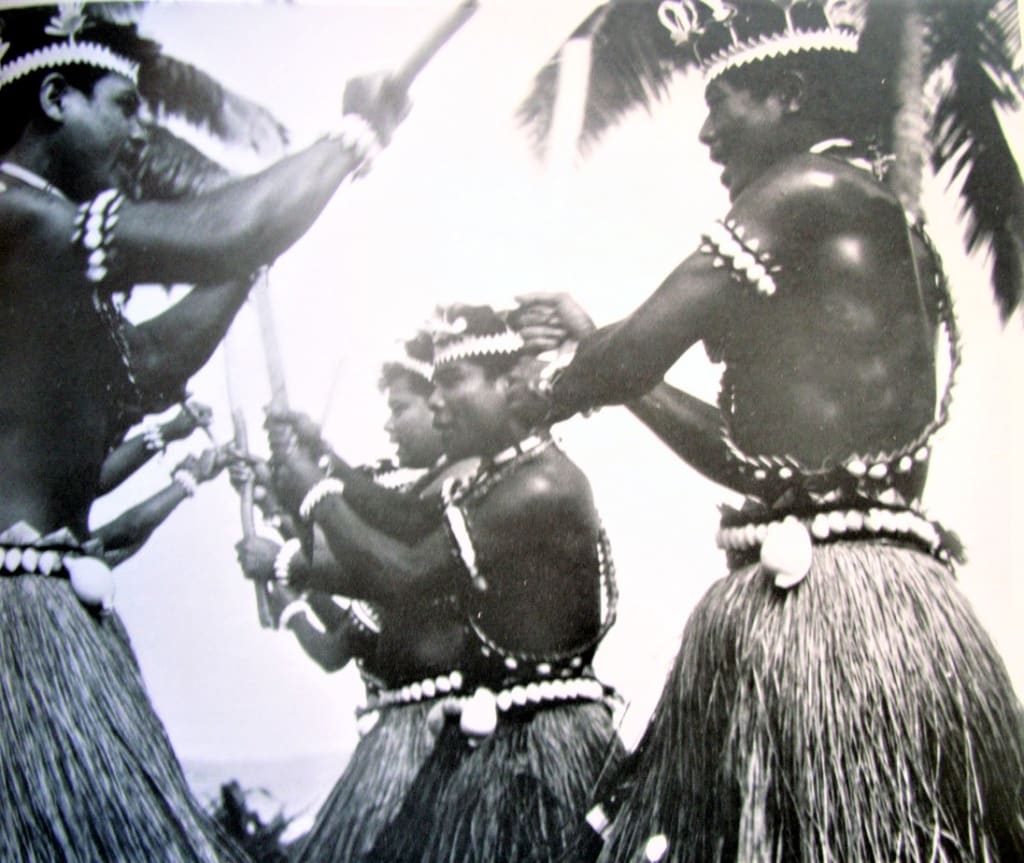
A Dance Inciting Warriors to Battle [1]
The chant Emananga emanangananga is part of a much longer chant used in the historic Te Karanga. It is a preface to war. Among its cries is IA IA E MATE (the enemy is already dead). This shows that it probably has been used as a coercive chant that will bring victory to the Banaban against their enemies.
Te Karanga, a chant which is an epic story, is danced today with long staves. It is believed to be extremely old. Both men and women now take part. It has very intricate beats in the clashes of the dancers’ staves as the lines of performers flow past, around and through each other.
Te Karanga concerns the powerful spirit creature of Ocean Island, Auriaria. He waged war in many islands and overcame them all because Teiei Itibubua, the essence of physical power - the mighty seven-headed god of war, the one god with the strength of seven hundred sails - was always on his side. Emananga emanangananga is a dance for men only.
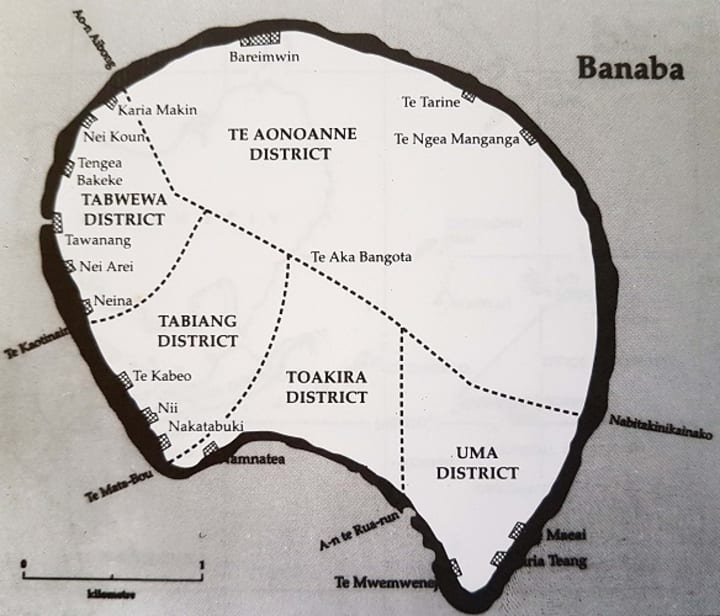
The story of the battle behind Te Karanga (war spear dance) and Te Karanga Are E Uarereke (the war club dance) [2]
Te Karanga is a War dance re-enactment of the battle between the indigenous Te Aka and the invasion of Banaba by the Auriaria clan.
Te Karanga Are E Uarereke (The War Club Dance) is the re-enactment of the land disputes that began after the arrival of Auriaria. The dance is performed only by men, usually in pairs. Even though it is an aggressive style of dance, it has no connection with the war spear dance, te karanga. The war club dance imitates two men arguing and fighting over land boundaries.
In the te karanga, all the dancers interact in complicated movements to imitate a full-scale battle. The dancer in te karanga are e uarereke holds a war club in both hands, and the object of the dance is to strike the partner, who blocks the
blows with his club. It is a well-timed, well-choreographed dance with intricate moves performed only with the opposite partner. The music backing for this dance comes from the chanting and stamping of the feet of the dancers.
There is very little known regarding the dances of the Auriaria clan. They were regarded as seafarers and warriors. Their cultural influence eventually merged with that of Te Aka clan especially after a few generations of intermarriage. Many more dances were introduced to the Banaban people after the arrival of Nei Anginimaeao nearly a century later.
Banaban dancing on Rabi now has evolved from its original war dances into more flowing movements, especially among the women. The men have adopted more aggressive movements based on self-defence. Their actions could compare with what we see in current forms of martial arts in western society.
Te Karanga an enactment of the Battle of Tairua [3]
After Auriaria and his party landed at Tabwewa canoe passage on Banaba, they realised that the island was already inhabited. They met with strong opposition from Te Aka people and, according to oral history, this is known as the epic Battle of Tairua: Tairua means foreigners or outsiders. Auriaria and his party were experts in warfare. They defeated Te Aka, driving them back to the northern region and creating a land partition right across the centre of the island. The north-west boundary was marked from a place at the shoreline called Aon Aibong, and up over the plateau to the south-east shoreline called Nabitakinikainako. Auriaria had already decided to settle at Tabwewa and began dividing the area into hamlets among his
people. Clan records do not include the names of all those in the invading party nor the total number involved. Even though the shy and secretive Te Aka were defeated at the Battle of Tairua, it took many years for them to accept the new invaders and for social interaction to begin.
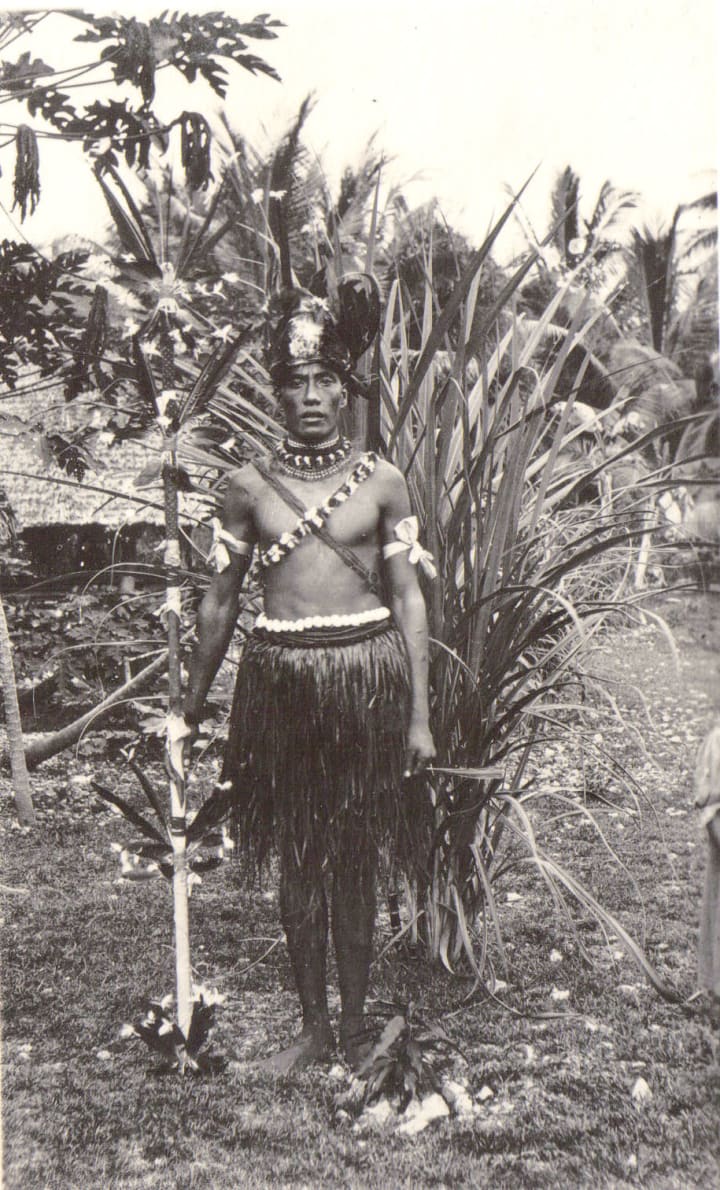
Banaban Chant - Emananga emanangananga
Literal Tranlation:
Chant: Maua Tianako
Lit: Warning / Signal to begin
Chant: Emananga emanangananga
Lit: To start up / to go… go… go
Chant: Te katitireuakina te anti Temanna teitei itibubua
Lit: The / flattening: killing / the / god / one / sail / 700
Chant: Ko no ira boan au kai ma karerekanako
Lit: You / in / join / strike / my / war club / with / so hard it flew
(singular) future of wood to make (it) go (nako)
tense fly (rere)
Chant: irarikin karawa
Lit: Speed away / sky or heavenward (heavenside)
(rariki - at the side)
Chant: Ko ongo neana bukina ma tokitokina
Lit: You / hear / sound / thump / with / succession of thumps
(Singular) (to resound) (toki - to sop as by stubbing)
Chant: Ia ia e bo ia ia e teke ia ia e mate
Lit: Where / to / strike / where / to / stab / where / to / kill
(past. Inferring he is already dead)
Chant: I korea e mwakoro, i koreia e mwakoro
Lit: I / chop: cut / it is chopped / I / chopcut / it is chopped
Chant: Ia ia iaiaia ia kunkung oe!
Lit: Where where where / all is well / (a cheer) Hooray!
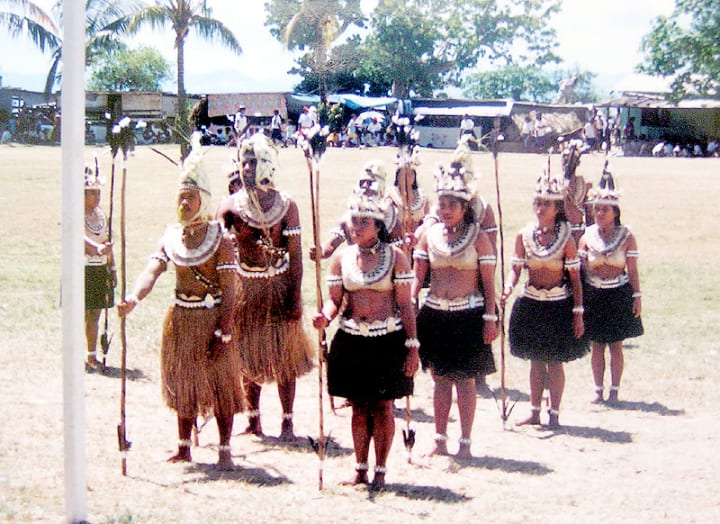
Emananga Emanangannga
(Division of Line Numbers into Sections Conforming with the Written Choreography)
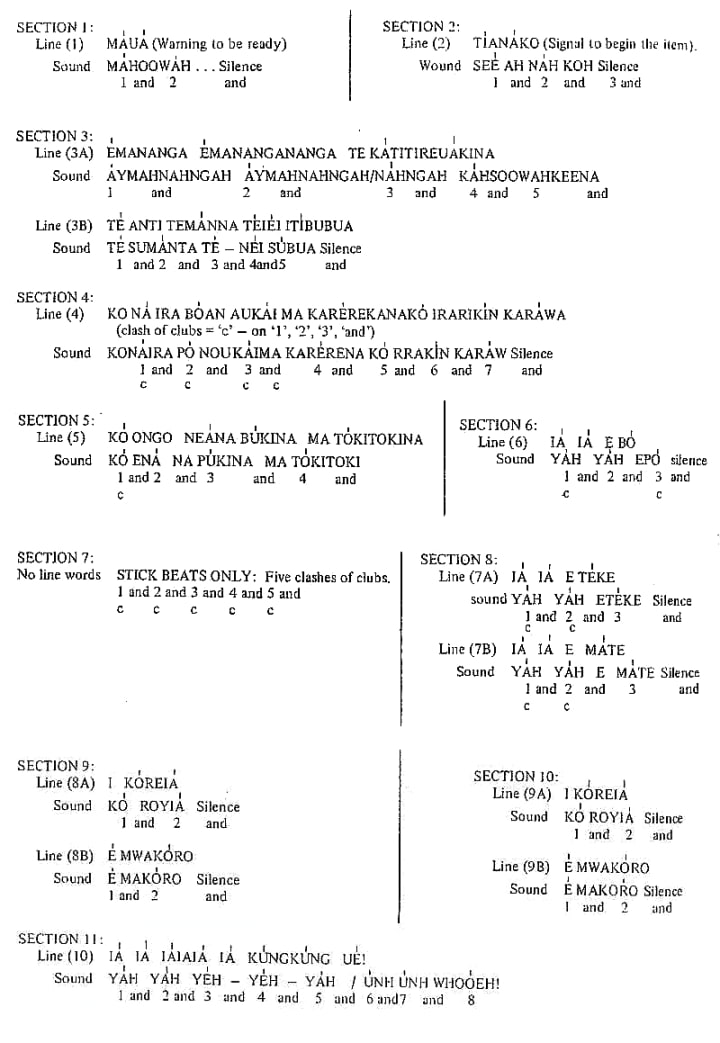
Banaban Choreographer [4]
Tawaka Tekenimatang is a revered Tetia Kaeni Kamaen, or choreographer. This title is achieved only after long discipline and difficult taboos. His status has about it the aura of the supernatural, as such one is said to have powers of doing evil if you harm him but he also can use studies and powers for healing purposes. Tawaka did no choreography until after the age of 30. He says that he creates his dances solely from 'just concentrating'. Tawaka was born in Uma Village on Banaba (Ocean Island) on December 27, 1912. Tawaka is both Director and choreographer of the Banaban Dancers.
Music for Banaban Dance [5]
The accompaniment for the Micronesian Banaban dance Emananga Emanangananga is the chanting shouts of the men as they dance, clicking their staves and war clubs together and stamping their feet.
Most Banaban dance has large, seated groups of chanting singers who shout the words and clap their hands rhythmically to accompany the movements. Usually, each verse starts off as a steady tempo and then accelerates to a peak of exciting rhythmic insistence at the climax.
Banaban Costume
Both men and women wear the short kilt cut just above the knee. The women's type is sometimes dyed black while that of the men is a darkish brown. The kilts are made of the young palm tree fronds or the shredded inner bark of the hibiscus plant. Stark shite shells at the waist, the wrist and even the ankles are in sharp contrast against the darkness of the costume.
Both men and women wear intricate crowns. For Banaban men the crown is made of dried vine. Elaborate necklaces are worn and these are fashioned of pandanus. The women also sometimes wear delicately fashioned bracelets of fibre on their arms. All of them seem distant replicas of some of the golden metal and diamante styles worn by Balinese dancers.
The following Te Karanga performed by Te Nati n Banaba iaon Tarawa (the sons and daughters of Banaba on Tarawa) at the 15 December Celebrations held Tarawa, Kiribati on the 18 December 2021.
Te Karanga choreographer Maraki Ruteru.
Acknowledgments:
"Among the Banaban people in Rabi island l wish to thank, in particular, the members of the Rotan family and the distinguished Tetia Kaeni Kamaen (the choreographer), Tawaka Tekenimatang: Makin Corrie Tekenimatang and Teena, both of whom translated for me, the members of the Banaban Dancing Club and all the many people whose warmth and kindness have been so encouraging during each of my four sojourns amongst them." Beth Dean
Continued PART TWO: Choreography including the Music Phrase and Counts for the Emananga Emanangananga - A Dance Inciting Warriors to Battle
____________________________________________________
1. Original copyright: The Banaban Dancing Club for whom Tawaka Tekenimatang is Choreographer.
2. Excerpt: 'Part One: Te Aka, Chapter 3: Myths and Legends, Te Rii ni Banaba, backbone of Banaba'.
3. Excerpt: 'Part Two: Auriaria, Chapter 8: The First Invasion of Banaba, Te Rii ni Banaba, backbone of Banaba'.
4. Original copyright: The Banaban Dancing Club for whom Tawaka Tekenimatan is Choreographer.
5. Excerpt: ‘Three Dances of Oceania’ by Beth Dean, First Published: Sydney Opera House Trust. January 1, 1976. Translation by Makin Corrie Tekenimatang.
____________________________________________________
Get the Book!
Read more about Banaban traditional dance and the epic history of Banaba (Ocean Island) and the Banaban people (The Forgotten People of the Pacific) as they try and seek justice to save their island, their culture, their future, "Te Rii ni Banaba- backbone of Banaba" by Raobeia Ken Sigrah and Stacey M King, available on Amazon here.
About the Creator
Stacey King
Stacey King, a published Australian author and historian. Her writing focuses on her mission to build global awareness of the plight of the indigenous Banaban people and her achievements as a businesswoman, entrepreneur and philanthropist.




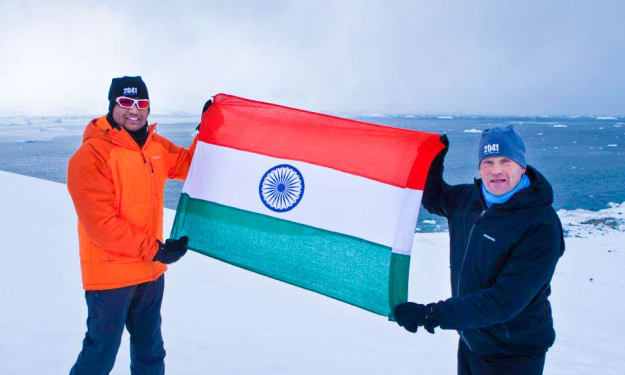

Comments
There are no comments for this story
Be the first to respond and start the conversation.